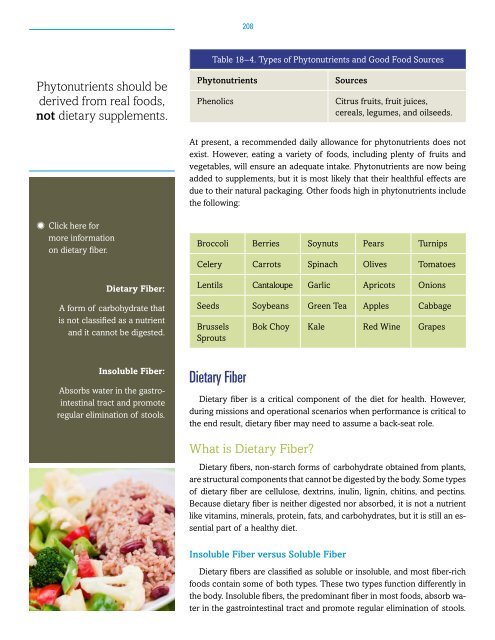special-operations-nutrition-guide
special-operations-nutrition-guide
special-operations-nutrition-guide
Create successful ePaper yourself
Turn your PDF publications into a flip-book with our unique Google optimized e-Paper software.
208<br />
Table 18–4. Types of Phytonutrients and Good Food Sources<br />
Phytonutrients should be<br />
derived from real foods,<br />
not dietary supplements.<br />
Phytonutrients<br />
Phenolics<br />
Sources<br />
Citrus fruits, fruit juices,<br />
cereals, legumes, and oilseeds.<br />
At present, a recommended daily allowance for phytonutrients does not<br />
exist. However, eating a variety of foods, including plenty of fruits and<br />
vegetables, will ensure an adequate intake. Phytonutrients are now being<br />
added to supplements, but it is most likely that their healthful effects are<br />
due to their natural packaging. Other foods high in phytonutrients include<br />
the following:<br />
==Click here for<br />
more information<br />
on dietary fiber.<br />
Dietary Fiber:<br />
A form of carbohydrate that<br />
is not classified as a nutrient<br />
and it cannot be digested.<br />
Broccoli Berries Soynuts Pears Turnips<br />
Celery Carrots Spinach Olives Tomatoes<br />
Lentils Cantaloupe Garlic Apricots Onions<br />
Seeds Soybeans Green Tea Apples Cabbage<br />
Brussels<br />
Sprouts<br />
Bok Choy Kale Red Wine Grapes<br />
Insoluble Fiber:<br />
Absorbs water in the gastrointestinal<br />
tract and promote<br />
regular elimination of stools.<br />
Dietary Fiber<br />
Dietary fiber is a critical component of the diet for health. However,<br />
during missions and operational scenarios when performance is critical to<br />
the end result, dietary fiber may need to assume a back-seat role.<br />
What is Dietary Fiber?<br />
Dietary fibers, non-starch forms of carbohydrate obtained from plants,<br />
are structural components that cannot be digested by the body. Some types<br />
of dietary fiber are cellulose, dextrins, inulin, lignin, chitins, and pectins.<br />
Because dietary fiber is neither digested nor absorbed, it is not a nutrient<br />
like vitamins, minerals, protein, fats, and carbohydrates, but it is still an essential<br />
part of a healthy diet.<br />
Insoluble Fiber versus Soluble Fiber<br />
Dietary fibers are classified as soluble or insoluble, and most fiber-rich<br />
foods contain some of both types. These two types function differently in<br />
the body. Insoluble fibers, the predominant fiber in most foods, absorb water<br />
in the gastrointestinal tract and promote regular elimination of stools.


